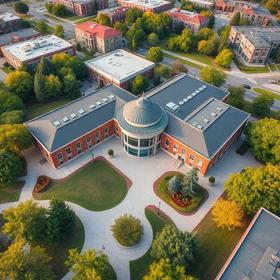- Cisco College seeks to encourage life-long learning and enhance the quality of life in the communities it serves by maintaining an open-door admissions policy and providing a comprehensive array of learning, service, and life experiences that will motivate and challenge students. In order to meet the needs of a diverse constituency, the College offers a variety of programs and courses in academic higher education, workforce development, and personal growth development. Faculty participate in continued professional development with a commitment to research and innovation as a basis for curriculum development. Associate’s degrees designed for transfer to a university, associate’s degrees and certificates designed for direct entry into the workforce, and opportunities for job skills continuing education and personal life enrichment are all a part of the dynamic offerings found at Cisco College.
School Highlights
Cisco College serves 4,042 students (29% of students are full-time).
The college's student-teacher ratio of 16:1 is lower than the state community college average of 23:1.
Minority enrollment is 47% of the student body (majority Hispanic), which is less than the state average of 74%.
Quick Facts (2026)
- Enrollment: 4,042 students
- In-state tuition: $4,260
- Out-state tuition: $4,260
- Student-teacher ratio: 16:1
- Minority enrollment: 47%
- Source: Integrated Postsecondary Education Data System (IPEDS)
School Overview
The teacher population of 250 teachers has stayed relatively flat over five years.
Cisco College
(TX) Community College Avg.
Carnegie Classification
Associate's Colleges: Mixed Transfer/Career & Technical-High Traditional
Baccalaureate/Associate's Colleges: Associate's Dominant
Institution Level
At least 2 but less than 4 years
At least 2 but less than 4 years
Institution Control
Public
Public
Year Founded
1940
Colors
White, Blue
Total Faculty
250 staff
262 staff
School Calendar
Student Body
The student population of Cisco College has grown by 24% over five years.
The student-teacher ratio of 16:1 has decreased from 29:1 over five years.
The Cisco College diversity score of 0.63 is less than the state average of 0.70. The school's diversity has stayed relatively flat over five years.
Total Enrollment
4,042 students
4,931 students
Student-Teacher Ratio
16:1
23:1
# Full-Time Students
1,181 students
909 students
# Part-Time Students
2,861 students
4,022 students
# Enrollment Undergraduate
404 students
403 students
# Full-Time Undergraduate Students
1,181 students
890 students
# Full-Time Graduate Students
n/a
40 students
# Part-Time Undergraduate Students
2,861 students
4,166 students
# Part-Time Graduate Students
n/a
47 students
Total Dormitory Capacity
363 students
252 students
% American Indian/Alaskan
n/a
n/a
% Asian
1%
6%
% Hispanic
28%
46%
% Black
9%
13%
% White
53%
26%
% Hawaiian
1%
n/a
% Two or more races
4%
3%
% Non Resident races
n/a
2%
% Unknown races
4%
4%
Diversity Score
0.63
0.70
College Completion Rate (Students who graduate in less than 4 years)
26%
55%
College Completion Rate (Students who graduate in 4 years or more than 4 years)
n/a
34%
Average Graduate Earnings (10 Years)
$34,900
$34,600
Tuition and Acceptance Rate
The public in-state tuition of $4,260 is more than the state average of $3,764. The in-state tuition has declined by 12% over four years.
The public out-state tuition of $4,260 is less than the state average of $6,054. The out-state tuition has declined by 12% over four years.
In-State Tuition Fees
$4,260
$3,764
Out-State Tuition Fees
$4,260
$6,054
% Students Receiving Some Financial Aid
87%
84%
Median Debt for Graduates
$10,750
$9,584
Median Debt for Dropouts
$5,500
$5,250
Acceptance Rate
n/a
84%
Source: 2024 (or latest year available) Integrated Postsecondary Education Data System (IPEDS) , School Administrators
School Notes
- On May 8, 1939, after months of planning and consultation with state officials, Cisco citizens succeeded in getting enacted into legislation a bill which created Cisco Junior College as a part of the Cisco Independent School District. R.N. Cluck, superintendent of Cisco schools, who had devoted years to the project, became its first president. Randolph College properties were purchased, the college was formally opened in September, 1939, and the first students were received in 1940. Such was the success of this venture that in 1956 the college was separated from the public schools, and a Board of Regents was elected. Since that time the high-quality, low-cost, state-supported educational programs have enabled Cisco Junior College to satisfy the needs of students from its service area and from across Texas. Cisco Junior College is dedicated to providing quality education to its students by a competent and caring faculty. A comprehensive program of knowledge, skills, and experiences is provided through curricula for academic transfer, career preparation, and continuing adult education. In support of this educational mission, the College promotes student success through a program of placement assessment, skill development, and a comprehensive program of student services. Cisco Junior College is accredited by the Commission on Colleges of the Southern Association of Colleges and Schools to award the associate level degree.
Frequently Asked Questions
How much does Cisco College cost?
Cisco College's tuition is approximately $4,260 for In-State students and $4,260 for Out-State students.
Recent Articles

Part-Time vs. Full-Time Enrollment in 2025: Which Is Better?
Explore part-time vs. full-time enrollment in 2025, comparing costs, flexibility, outcomes, and goals to help students choose the right path.

How Community Colleges Use AI Tools to Support Student Success
Explore how community colleges are using AI tools in 2025 to improve advising, learning, retention, and student success.

Nontraditional Student’s Guide to Community College 2025
Comprehensive guide for nontraditional students at community college with updated tuition, support, careers, and success strategies for 2025.









